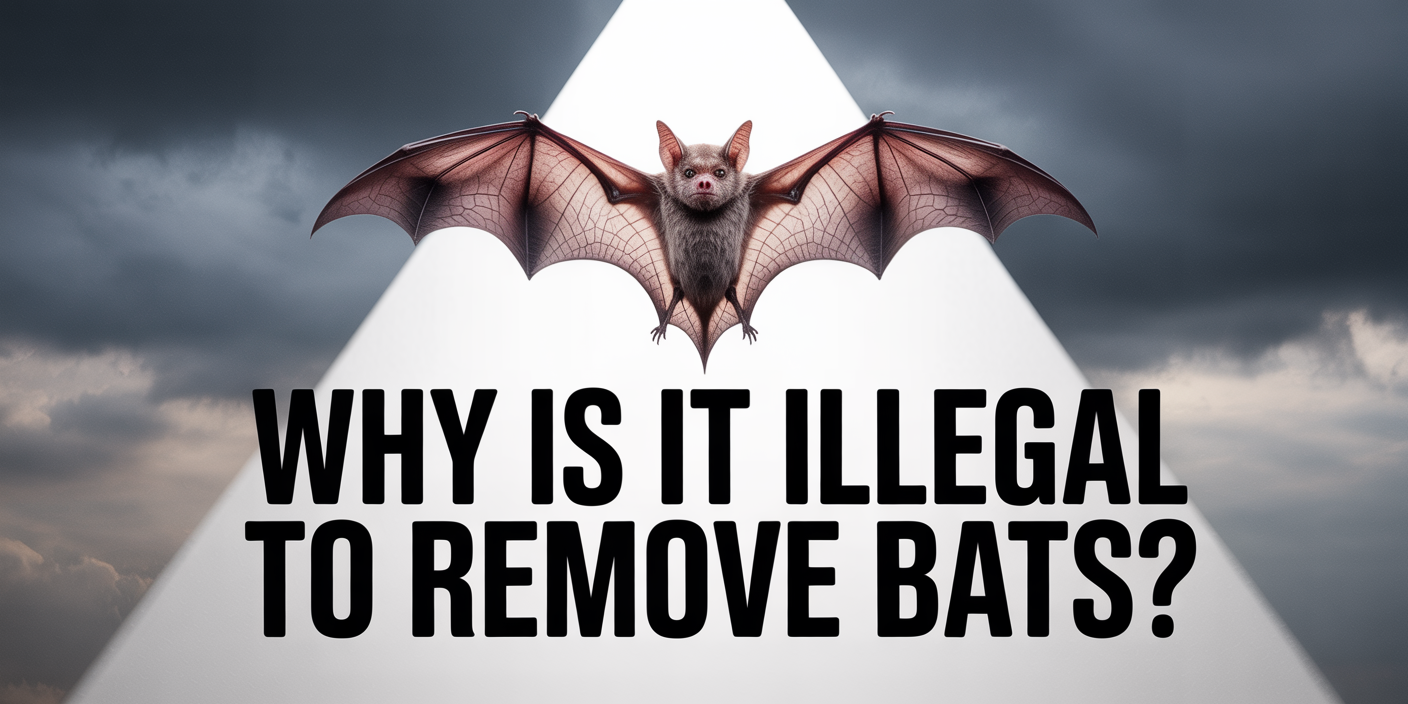It’s illegal to remove bats because they are protected under state and federal wildlife laws that regulate how and when they can be handled. These laws are designed to prevent harm during sensitive periods like maternity season, when baby bats are unable to fly. Removing bats outside of approved methods or timelines can result in fines, legal penalties, and unintended ecological harm.
So, you’ve got bats in the attic, or maybe you’ve spotted them slipping out from under the roofline at dusk like tiny winged fugitives. Your gut says to grab a flashlight, plug the holes, and call it a day. The problem? That instinct could get you into legal trouble fast. Bat removal isn’t just a household chore, it’s a regulated process with strict rules about when and how it can be done.
What most homeowners don’t realize is that removing bats the wrong way can actually be illegal, thanks to wildlife protection laws that exist for very real, science-backed reasons. In this guide, we’ll break down why these laws matter, how people accidentally cross the line, and how partnering with licensed experts like AAAC Wildlife Removal keeps you safe, compliant, and completely bat-free, without the legal headaches.
Why Bats Get Legal Protection (and Why That Matters to You)
Before you write bats off as pests with wings, it helps to understand why so many wildlife laws defend them in the first place. These laws aren’t just feel-good rules for nature lovers, they exist because bats pull serious weight when it comes to keeping our ecosystems (and your backyard) in check.
Here’s what bats are doing behind the scenes:
- Natural Pest Control Powerhouses
A single bat can eat up to 1,000 mosquitoes in just one hour. Multiply that by a whole colony, and you’ve got free, non-toxic pest control working every night while you sleep. - Crop-Saving Pollinators and Seed Spreaders
Certain species help pollinate plants and disperse seeds, which supports forests and farmland alike. In some parts of the world, they even pollinate crops like bananas, mangoes, and agave. - Silent Heroes of Biodiversity
By managing insect populations and supporting plant life, bats help keep delicate food chains balanced. When bat populations drop, pest populations spike, and that can throw an entire local ecosystem out of whack.
The takeaway? Bats aren’t just hanging out in your attic for fun, they’re federally and locally protected because of the huge environmental impact they make. Which is why removing them without proper timing and technique can land you in legal trouble fast.
Why You Can’t Just Remove Bats Anytime You Want
Removing bats might seem like a quick weekend fix, but laws across the U.S. make that a legally risky move. Wildlife protection rules aren’t there to inconvenience homeowners; they exist to prevent ecological damage, health hazards, and animal cruelty. If you’re not careful, one hasty decision could turn into a violation that’s hard to undo.
Protected Under Wildlife Laws
Bats are classified as protected species in many states, especially those with shrinking populations. While some protections stem from federal guidelines like the Migratory Bird Treaty Act, most states enforce their own regulations based on local bat activity. Interfering with a roost, even unintentionally, can quickly cross into illegal territory if the timing or method goes against those rules.
Maternity Season Restrictions
One of the biggest legal tripwires is removing bats during maternity season. From late spring to early summer, mother bats are raising their flightless pups inside attics, chimneys, and soffits. If you block access during this time, you’re likely trapping helpless babies inside, something that’s not just unethical but considered illegal in many jurisdictions.
Banned Methods and Unsafe Exclusions
Homeowners often reach for shortcuts when bats make themselves at home, but many of those go-to solutions are flat-out illegal. Using poisons, chemical sprays, or stuffing foam into exit points might feel effective, but these tactics are either banned or heavily regulated. Without the right setup, you could end up harming the bats, damaging your home, or both, and none of that holds up in court.
Structural Modifications Without Inspection
Another overlooked issue is sealing entry points without verifying if bats are still inside. It’s illegal to trap bats by accident, even if you didn’t mean to do it. Wildlife laws often require that a full inspection and exclusion process be completed before any permanent work is done. Skip that step, and you risk violating legal protections, even if your goal was to help.
Bat Removal Gone Wrong: What It Could Cost You
Trying to handle a bat issue on your own can feel like the faster route, until it isn’t. Laws protecting bats are strictly enforced, and if you make the wrong move, you’re not just risking a slap on the wrist. You could be facing steep fines, criminal charges, and more paperwork than you ever wanted to see over a few winged intruders.
Fines and Misdemeanors Add Up Fast
In many states, killing bats, even unintentionally, can trigger misdemeanor wildlife violations. These usually carry fines ranging from $500 to $5,000 per offense, depending on the state and circumstances. In some areas, the law can escalate to probation or even jail time, especially if protected species are harmed or if you used banned methods like glue traps, sprays, or sealed entries.
State Penalties You Might Not Expect
In Florida, it’s illegal to exclude bats during maternity season, which typically runs from April 15 to August 15. Violators can be cited by the Florida Fish and Wildlife Conservation Commission and hit with serious penalties. Texas classifies bats as nongame animals, but if you kill or trap them outside the legal guidelines, you could be fined up to $2,000 per incident under state wildlife codes. In California, unauthorized killing of bats is considered a crime and may lead to criminal prosecution. New York takes it a step further, many bat species are federally protected, and harming them can trigger federal wildlife charges, not just state-level ones.
The Fallout Doesn’t Stop at Fines
Even if you dodge a citation, the consequences can show up in other ways. Homeowner’s insurance often won’t cover damages caused by illegal wildlife removal attempts. That includes contamination from trapped bats, attic repairs, or structural changes made without a permit. On top of that, HOA rules or city ordinances may come into play if your DIY methods disturb neighbors or create public health risks.
The Right Way to Get Bats Out (Without Breaking the Law)
If bats have taken up residence in your attic, you’re not powerless, but you are on a legal tightrope. Getting rid of them the wrong way can lead to fines, structural issues, and even criminal charges. That’s why legal bat removal isn’t about acting fast. It’s about acting smart.
The lawful process starts with a proper inspection from licensed professionals who understand bat behavior and local wildlife laws. Timing is critical. Exclusions can only be done outside of maternity season, using one-way exit devices that let bats leave safely without letting them return. Once every bat is confirmed gone, experts can seal all access points and clean contaminated spaces without causing harm or breaking the rules.
DIY bat removal can seem like the cheaper fix, but one wrong move could cost you more than you bargained for. That’s exactly why AAAC Wildlife Removal handles the process legally, humanely, and by the book, so you can get peace of mind without playing legal roulette. If you’re facing a bat problem, don’t risk guessing your way through it. Let the experts handle it the right way, the first time.




